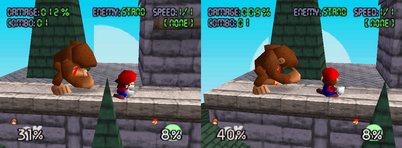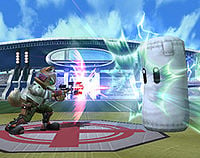Stale-move negation

Stale-move negation is a gameplay element in the Super Smash Bros. series. It refers to how moves cause less damage and knockback as they are used multiple times in a row. The strength of a move increases back to its regular power as other moves are used. Starting in Melee, being KO'd resets the staleness of all of that player's moves.
Masahiro Sakurai added stale move negation to the Super Smash Bros. series in order to encourage players to try different attacks out and use characters to their fullest instead of using a single move repeatedly.
An important note is that stale move negation is applied to the whole attack rather than individual hitboxes. As such, landing the weak hitbox will weaken all hitboxes in the attack just as landing the strongest hitbox would.
Moves that are counter-attacks or absorbers do not take the stale move negation of the incoming attack into consideration. Items are also affected by stale move negation, even if the player drops the item they're holding and picks up a different one of the same.
Calculation
SSB
When a move connects in SSB, it is then considered stale. Any consecutive uses of the move will deal 0.75x damage; using the move more than twice in a row does not incur an additional penalty. Hitting with other moves will increase the power of the move over a sequence of three intermediate stages between "stale" and "fresh" before reaching full power.
As SSB rounds up damage done by attacks, moves that deal less damage are less affected by stale move negation, to the point where attacks that deal just 1% damage are essentially immune. Weaker moves will also essentially reach full power in fewer stages; any attack that deals 24% damage or less will (after rounding up) be dealing full damage one stage before they are considered perfectly fresh.
| Stale | Level 1 | Level 2 | Level 3 | Fresh |
|---|---|---|---|---|
| 0.75x | 0.82x | 0.89x | 0.96x | 1.0x |
Using a single move as 35% or more of one's attacks during a match awards the Cheap Shot bonus, worth -99 points. The bonus is not actually connected to stale-move negation; in fact it is possible (though unlikely) to earn it even by using two other moves in between the repeated move.
Melee and Brawl

Stale move negation is calculated with a queue of the last nine moves a character has connected with. When a move is used that's in the queue, its damage is decreased an amount based on both how often the move is in the queue and how recently the move has been used. If a move is used ten times in a row (that is, the queue is full of only that move), it will have lost about half of its power.
| Queue position | 1 | 2 | 3 | 4 | 5 | 6 | 7 | 8 | 9 |
|---|---|---|---|---|---|---|---|---|---|
| Reduction factor (Melee) | 0.09 | 0.08 | 0.07 | 0.06 | 0.05 | 0.04 | 0.03 | 0.02 | 0.01 |
| Reduction factor (Brawl) | 0.1 | 0.09 | 0.08 | 0.07 | 0.06 | 0.05 | 0.04 | 0.03 | 0.02 |
In Melee, the Stale Moves bonus (worth -2000 points) is awarded under certain (currently unclear) conditions, possibly (but, like Cheap Shot, not necessarily) related to how stale one allows a move to get.
In Brawl, if a move is not in the list of recently-used moves, it earns a freshness bonus of 1.05x damage - therefore, very few attacks ever deal the exact damage they are programmed to do.
Testing to determine the stale move negation effect in Brawl initially confused players, as the effect is not applied in Brawl's Training Mode (the confusion stemming from the fact that is was applied in the training modes of Super Smash Bros. and Melee). This is due to the fact that stale move negation is not applied in any of the 1P modes in Brawl, except for in the Home-Run Contest.
An interesting quirk of stale-move negation in Brawl is how it acts if an attack's ending lag is interrupted by another instance of the same attack - the move is put unto the queue for each time it hits, but the attack doesn't decrease in damage until the character enters a different action. For example, multiple quick hits of Meta Knight or Marth's down tilt will all deal maximum damage if initiated during the cooldown of the previous one, not decreasing in damage until the chain ends and the character enters their crouching or standing state.
Controversy
While the damage reduction caused by stale-move negation is about the same in Brawl as in Melee, the calculation of knockback in Melee ignores it, while Brawl does not. As the damage of a hitbox is a main component in the knockback formula this results in a much more noticeable drop in the knockback of a stale attack.
The much more severe stale move negation in Brawl has had a mixed reception among the competitive fanbase. Those who support the severe stale move negation argue that it adds more strategy and depth to the game, giving importance to "saving finishers" until the opponent is in the KO range, while rewarding those who plan the use of their attacks appropriately, and punishing those who rely on their KO attacks to rack up damage. Detractors argue that it allows some attacks to combo into themselves much more effectively than they should, resulting in them being overly powerful damage rackers at low percents. This has been the primary cause of some hard counter matchups, with the most notorious examples of such attacks being Pikachu's down throw and Sheik's forward tilt.
Some mods of Brawl, with the developers having the sentiment of the detractors, alter stale move negation; some reduce its powers to varying degrees, while others remove it altogether.
Moves that stale-move negation does not affect
The following moves are not affected by stale-move negation:
- Recoil damage is not subject to stale-move negation. For example, Roy's fully charged Flare Blade will do the same amount of damage to Roy regardless of how much damage it is doing to the opponent.
- Donkey Kong's cargo throw always does 10% to his victim
- The Clawshot used in midair (always 4% first hit, 6% second hit if spaced correctly)
- The Hookshot used in midair (always 4%)
- The Grapple Beam used in midair (always 4%, always 7% if tipped)
- Zero Suit Samus' neutral air (always 10%)
- Luigi's down taunt (always 1% in Super Smash Bros. and Melee, always 2% in Brawl)
- Snake's Hand Grenade's explosion (always 12%-13%)